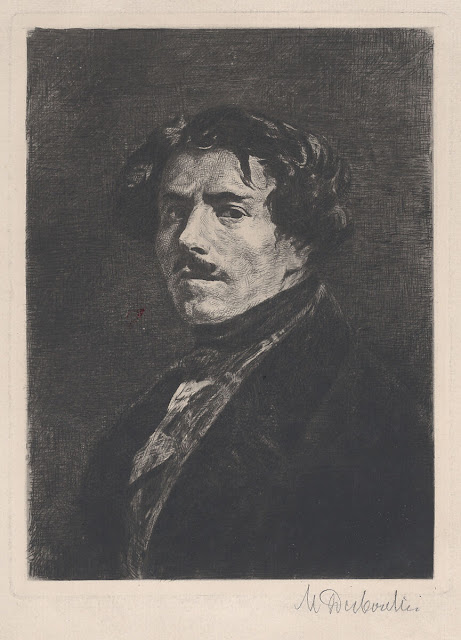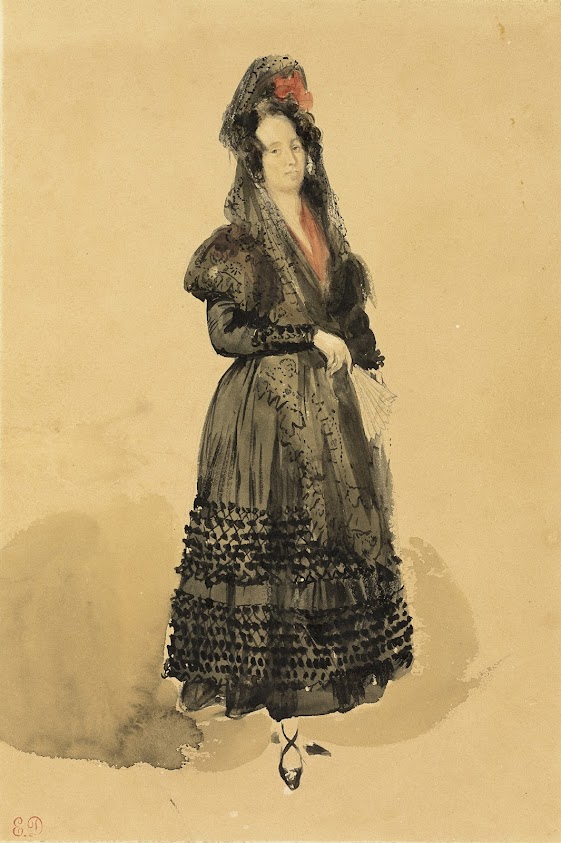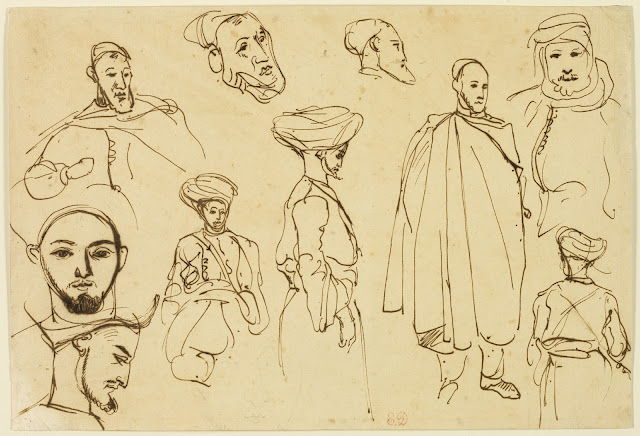 |
| 1889 Portrait of Eugène Delacroix by Marcellin Desboutin heliogravure The Metropolitan Museum of Art, New York |
Poet and art critic Charles Baudelaire described his hero Eugène Delacroix as "a volcanic crater artistically concealed beneath bouquets of flowers." Beneath the surface of Delacroix's polished elegance and charm roiled turbulent interior emotions. In 1822 Delacroix took the Salon by storm. Although the French artistic establishment considered him a wild man and a rebel, the French government, bought his paintings and commissioned murals throughout Paris. Though Delacroix aimed to balance classicism and Romanticism, his art cenreed on a revolutionary idea born with the Romantics: that art should be created out of sincerity, that it should express the artist's true feelings and convictions. Educated firmly in the classics, Delacroix often depicted mythological subjects, themes encouraged by the reigning Neoclassical artists at the Académie des Beaux-Arts. But Delacroix's brilliant colors and passionate brushwork frightened them; their watchwords were "noble simplicity and calm grandeur." They barred him from academy membership until 1857, and even then he was prohibited from teaching in the École des Beaux-Arts. For those very reasons, he was an inspiration to the Impressionists and other young artists. Paul Cézanne once said, "We are all in Delacroix." Intensely private, Delacroix kept a journal that is renowned as a profoundly moving record of the artistic experience.
This is part 3 of of a 6-part series on the works of Eugène Delacroix:
 |
| 1829-30 Lion of the Atlas Mountains lithograph: probably second state of four 33 x 46.7 cm The Metropolitan Museum of Art, New York |
 |
| n.d. Lion Devouring a Rabbit pen and brown iron gall ink, over graphite, on ivory laid paper 26 x 32 cm Art Institute of Chicago, IL |
 |
| c1829 Studies of Lions graphite on cream laid paper 22.7 x 34.2 cm Art Institute of Chicago, IL |
*.jpg) |
| 1829-30 Royal Tiger lithograph in black on light grey China paper 32.5 x 46.4 cm (image) |
 |
| 1829-30 Royal Tiger watercolour and graphite on paper 17.8 x 26.8 cm The Morgan Library & Museum, New York City |
 |
| c1830 Royal Tiger watercolour on paper 14.1 x 25.1 cm National Gallery of Art, Washington, DC |
 |
| 1829-30 Sketch for the Battle of Poitiers oil on canvas 52 x 64.8 cm The Walters Museum, Baltimore, MD |
 |
| 1829-30 Sketch for the Battle of Poitiers detail |
 |
| 1829-30 Sketch for the Battle of Poitiers detail |
 |
| 1829-31 Interior of the Church of Valmont Abbey brown and grey wash over graphite 18.3 x 21.7 cm The Metropolitan Museum of Art, New York |
,%20Paris.jpg) |
| 1830 Liberty leading the People oil on canvas 260 x 325 cm © RMN - Grand Palais (Louvre museum), Paris |
 |
| 1830 Liberty leading the People detail |
 |
| 1830 Liberty leading the People detail |
 |
| 1830 Liberty leading the People study |
 |
| 1830s The Runaway Carriage pen and black ink on heavy laid paper 29.1 x 50.2 cm National Gallery of Art, Washington, DC |
1931 Interior of a Dominican Convent in Madrid
The subject of this painting is from a popular nineteenth-century English novel, Charles Maturin's Melmoth the Wanderer, translated into French in 1821. A young man forced into a convent as a child undergoes harrowing trials in order to escape his punitive and corrupt surroundings. Here he is shown being dragged before the bishop of Madrid. The artist depicts a cavernous, vaulted room that is actually based on the interior of the Palace of Justice in Rouen, France. Delacroix's use of this decidedly un-Spanish, secular setting may have been an intentional reference to the oppressive link between civic and religious power, a theme prominent in the novel.
 |
| 1831 Interior of a Dominican Convent in Madrid oil on canvas 130.2 x 161.9 cm Philadelphia Museum of Art, PA |
 |
| 1831 Interior of a Dominican Convent in Madrid detail |
 |
| 1831 Interior of a Dominican Convent in Madrid detail |
.jpg) |
| 1831 Normandy lithograph in black on ivory China paper 17.4 x 22.3 cm (image) |
 |
| 1831 Willibald Gluck at the Clavecin composing the score of his "Armide" brush and brown washes, heightened with white 22.7 x 17.4 cm Museum of Fine Arts, Boston, MA |
.jpg) |
| 1831 Young Tiger Playing with its Mother lithograph in black on buff wove paper 11.2 x 18.7 cm (image) |
 |
| c1831 Episode from "The Corsair" by Lord Byron watercolour, brown ink, touches of gouache, over graphite underdrawing 24.3 x 19.2 cm J. Paul Getty Museum, Los Angeles |
1832 A Moroccan Couple on Their Terrace
This is one of eighteen watercolours Delacroix presented to his travel companion, the diplomat Charles de Mornay, following their return from North Africa. The artist executed a number of the works while the men were quarantined for two weeks in Toulon. Inspired by the quality of Mediterranean light observed during the journey, he adopted a brighter palette than he had used previously. His fascination with Moroccan costume is apparent here in the attention he lavished on the multilayered attire of the woman, especially compared to his more abstract approach to other decorative aspects of the scene.
 |
| 1832 A Moroccan couple on their terrace watercolour over traces of graphite 13.7 x 18.9 cm The Metropolitan Museum of Art, New York |
 |
| 1832 Four sketches of Arab men watercolour and graphite, on tan wove paper 18.4 x 26.9 cm Art Institute of Chicago, IL |
 |
| 1832 Portrait of Amina Biasa, Minister of the Sultan of Morocco graphite and watercolour on paper Louvre Museum, Paris |
1832 Saada, the Wife of Abraham Ben-Chimol
The Met note: Delacroix produced this sumptuous watercolor on a trip to North Africa in 1832. He accompanied his friend the Count de Mornay on his mission as good-will ambassador to the Sultan of Morocco, Abd-er-Rahman II. Assigned to the delegation as dragoman was the Jewish interpreter Abraham Ben-Chimol (Abraham Benchimol) of Tangiers, who introduced the Frenchmen to his wife and to his daughter, pictured here in her bridal attire. In his "Journal," Delacroix described in extensive detail a Jewish wedding he attended in Tangiers on February 21, 1832.
 |
| 1832 Saada, the wife of Abraham Ben-Chimol, and Préciada, one of their daughters watercolour over graphite on wove paper 22.2 x 16.2 cm The Metropolitan Museum of Art, New York |
 |
| 1832 Young Moroccan, standing watercolour over pen and brown ink 19.4 x 6.7 cm The Metropolitan Museum of Art, New York |
 |
| 1832 Young Spanish lady in costume of Manola gouache and watercolour, with traces of scraping, over graphite, on cream wove paper 30.5 x 24.1 cm Art Institute of Chicago, IL |
 |
| 1832-33 A Portrait of Dr. François-Marie Desmaisons oil on canvas 88.9 x 8.3 cm Detroit Institute of Arts. MI |
1832-37 Three Arab Horsemen at an Encampment
Delacroix produced this watercolour based on his sketches, notes, and memories of a ten-day journey between Tangier and Meknès. The blue hills in the background evoke his description of the mountainous landscape as "violet in the morning and evening, blue during the day." He shows just three of the multitude of horsemen that accompanied the diplomatic envoy; two are seated at rest, while the central mounted figure adopts a posture reminiscent of Delacroix’s depictions of Sultan Abd er-Rahman.
 |
| 1832-37 Three Arab horsemen at an encampment watercolour over graphite 21.7 x 29.6 cm The Metropolitan Museum of Art, New York |
 |
| c1832 Arab horsemen black, white and red chalk on brown paper 22 x 28.7 cm National Gallery of Victoria, Melbourne, Australia |
 |
| c1832 Sketches of Algerian men pen and brown ink, with traces of graphite, on tan wove paper 20.5 x 30.2 cm Art Institute of Chicago, IL |
%20The%20Metropolitan%20Museum%20of%20Art,%20New%20York.jpg) |
| 1833 A Blacksmith aquatint, drypoint: between third and fourth state of six 16 x 9.8 cm (image) The Metropolitan Museum of Art, New York |
 |
| 1833 A Jewish Bride in Tangier etching: first state of four 21.3 x 17.3 cm |
.jpg) |
| 1833 A Lord from the time of Francis I etching and drypoint on white wove paper 17.3 x 12.7 cm (image) |
.jpg) |
| 1833 A Man with weapons etching on paper (size not given) |
 |
| 1833 A vase of flowers oil on canvas 57.7 x 48.8 cm © National Galleries of Scotland, Edinburgh |
.jpg) |
| 1833 Arabs of Oran etching, roulette and drypoint on ivory laid paper 14.4 x 19.3 cm (image) |
.jpg) |
| 1833 Chief Mohammed-Ben-Abou etching on off-white chine 14.2 x 21.3 cm (plate) |
1836-45 Goetz of Berlichingen
Drawing inspiration from literature and theatre, Eugène Delacroix developed a long-standing interest in the writer Johann Wolfgang von Goethe (1749–1832). He completed a series of prints based on the famous “Faust” (1828) and seven lithographs, including this one, from “Goetz of Berlichingen” published in German in 1773; and French in 1823) that tells the story of the life of a German knight (1480-1562) who fought to regain the privileges of free knights, nullified by the emperor Maximilian I in 1495. Goetz’s reputation as a noble knight spread so far that even the gypsies declared their loyalty to him and provided him with aid. Goethe highly praised Delacroix’s interpretations of scenes from his plays, such as this one.
 |
| 1836 Brother Martin clasping the iron hand of Goetz lithograph in black on ivory China paper 24.7 x 18.9 cm |
%20Art%20Institute%20of%20Chicago,%20IL.jpg) |
| 1836 The wounded Goetz cared for by the Bohemians lithograph in black with scrapping on stone, on thin off-white paper 30.4 x 23 cm (image) Art Institute of Chicago, IL |
%20The%20Metropolitan%20Museum%20of%20Art,%20New%20York.jpg) |
| 1836 Weislingen attacked by Goetz's men lithograph in black on white China paper 31.1 x 27.2 cm (image) The Metropolitan Museum of Art, New York |
 |
| 1836-43 Goetz von Berlichingen writing his memoirs graphite on beige wove paper 24.5 x 19.2 cm The Metropolitan Museum of Art, New York |
 |
| 1836-43 Goetz von Berlichingen writing his memoirs lithograph on paper 26.5 x 19.2 cm The Metropolitan Museum of Art, New York |
 |
| 1836-43 The Wounded Goetz taken in by the Gypsies lithograph on paper 30.4 x 23 cm The Metropolitan Museum of Art, New York |
.jpg) |
| c1836-43 The Death of Weislingen lithograph on paper 27.8 x 21.7 cm (image) |
 |
| 1842 Goetz van Berlichingen's horse pen and iron gall ink 13 x 19.2 cm The Metropolitan Museum of Art, New York |
%20The%20Metropolitan%20Museum%20of%20Art,%20New%20York.jpg) |
| 1843 Death of Goetz von Berlichingen wood engraving 21.8 x 14.6 cm (block) The Metropolitan Museum of Art, New York |
.jpg) |
| 1845 Goetz and Friar Martin wood engraving on paper 21.8 x 14.5 cm (block) |

.jpg)

.jpg)
.jpg)
.jpg)
%20.jpg)
.jpg)
.jpg)

.jpg)
.jpg)
.jpg)
.jpg)
.jpg)







%20The%20Metropolitan%20Museum%20of%20Art,%20New%20York.jpg)
.jpg)
%20The%20Metropolitan%20Museum%20of%20Art,%20New%20York.jpg)
%20Muse%CC%81e%20National%20Euge%CC%80ne%20Delacroix%20%C2%A9RMN-grand%20Palais,%20Louvre%20Museum,%20Paris.jpg)

.jpg)






.jpg)
.jpg)

